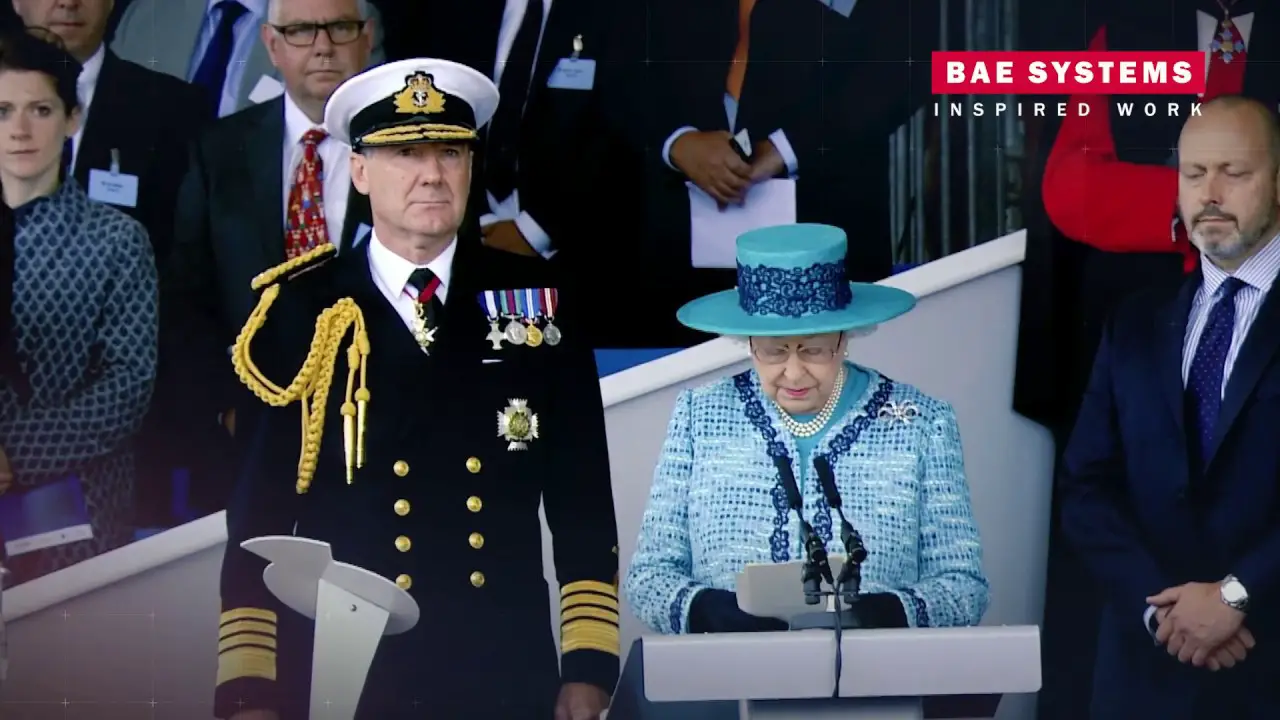Queen Elizabeth was named at Rosyth on 4 July 2014, by Elizabeth II, who said that the warship “marks a new phase in our naval history”. Instead of smashing the traditional bottle of champagne on the hull, she used a bottle of whisky from the Bowmore distillery on Islay. The ceremony was attended by the Duke of Edinburgh (the Lord High Admiral), Admiral George Zambellas (First Sea Lord), senior naval officers from the United States and France, and by politicians including David Cameron and Gordon Brown (the Prime Minister and his immediate predecessor) and Alex Salmond (the then First Minister of Scotland). The official piece of music HMS Queen Elizabeth March, composed by WO2 Bandmaster John Morrish, was performed at the naming ceremony by HM Royal Marines Band, Scotland. This piece of music is a competition winning march chosen by the Carrier Alliance Group, performed and recorded by the Royal Marines Massed Bands.
The ceremony also featured a fly-past by the Red Arrows and a second comprising navy, air force and army helicopters. HMS Illustrious was berthed adjacent to Queen Elizabeth during the ceremony. The ship was floated out of dry dock on the morning of 17 July 2014. Fitting out was completed at the end of 2015 and the crew moved aboard in May 2016. On 24 May 2016, Commodore Jeremy Kyd assumed command of the ship from Captain Simon Petitt who had been the Senior Naval Officer since October 2012 (joining with the first 8 crew).
HMS Queen Elizabeth, named for current reigning monarch Queen Elizabeth II, is the lead ship of the Queen Elizabeth class of aircraft carriers, the largest warships ever built for the Royal Navy of the United Kingdom and capable of carrying up to 40 aircraft. The ship began sea trials in June 2017, and was commissioned on 7 December 2017. Her first Commanding Officer is Commodore Jerry Kyd, who had previously commanded the carriers HMS Ark Royal and HMS Illustrious. As Captain of HMS Queen Elizabeth, Kyd will wear the Royal Navy rank of Captain while retaining the substantive rank of Commodore.
HMS Queen Elizabeth has no catapults or arrestor wires and is instead designed to operate V/STOL aircraft; the air wing will typically consist of F-35B Lightning II multirole fighters and Merlin helicopters for airborne early warning and anti-submarine warfare. The design emphasises flexibility, with accommodation for 250 Royal Marines and the ability to support them with attack helicopters and troop transports up to Chinook size and larger.She is the second Royal Navy vessel to bear the name Queen Elizabeth and is based at HMNB Portsmouth.
The two ships of the Queen Elizabeth class are each expected to be capable of carrying forty aircraft, a maximum of thirty-six F-35s and four helicopters. The 2010 SDSR anticipated the routine peacetime deployment of twelve F-35Bs, but a typical warload will be 24 F-35Bs and some helicopters. These could be a Maritime Force Protection package of nine anti-submarine Merlin HM2 and five Merlin Crowsnest for airborne early warning; alternatively a Littoral Manoeuvre package could include a mix of Royal Navy Commando Helicopter Force Merlin HC4, Wildcat AH1, RAF Chinooks, and Army Air Corps Apaches. As of September 2013 six landing spots are planned, but the deck could be marked out for the operation of ten medium helicopters at once, allowing the lift of a company of 250 troops. The hangars are designed for CH-47 Chinook operations without blade folding and for the V-22 Osprey tiltrotor, whilst the aircraft lifts can accommodate two Chinooks with unfolded blades.















